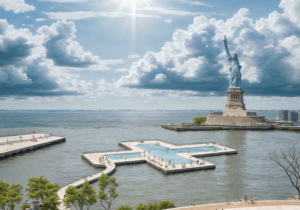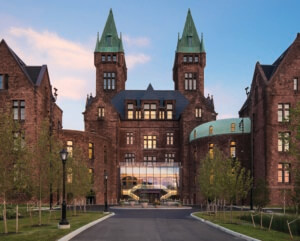For a psychiatric hospital built in the late 19th century, the Buffalo State Asylum for the Insane in Buffalo, New York, was remarkably ahead of its time. At the request of physician Thomas Story Kirkbride, who helmed the hospital’s design, emphasis was placed on access to natural light, fresh air, and pastoral views to benefit patient well-being. It was originally completed in 1880, combining Victorian and Romanesque elements.
Deborah Berke Partners (DBP) recently completed the asylum’s metamorphosis into the Hotel Henry Urban Resort and Conference Center. “The intentions for this building were about it being a welcoming and safe space,” said Stephen Brockman, senior principal of DBP. “The graciousness of the space is what’s fascinating. You open these doors, and it’s breathtaking,”
That said, converting the former asylum – located in the central portion of the sprawling National Historic Landmark Richardson Olmsted Campus – into a 191,000-square-foot luxury boutique hotel and conference center without losing its character was not without its challenges.
During early presentations of the project to the local community, conversations with the relatives of people who had spent time at the hospital and felt a close relationship with it created a desire “to make it feel like it was still theirs,” Brockman said. “Our interventions were subtle.”
The hotel and conference center houses 88 guest rooms, multiple conference facilities, a fine dining restaurant, a bar, and a cafe. Of the campus’s original 11 buildings, the hotel comprises three central buildings that were the asylum’s administrative hub and patient housing.
Along with the exterior, original interior elements, including windows, interior shutters, plasterwork, stairs, and tile and wood floors were preserved, while the grand staircase was restored. The spacious hallways, 200 feet long and 15 feet wide, were also kept intact. These corridors, which were originally called “day rooms” and functioned as the asylum’s social spaces, were flooded with ventilation and light to aid patient recovery.
“The grandeur of the building simply cried out to be a destination, so this is a perfect fit,” said Jean Carroon, principal at Goody Clancy, preservation architects for the project. “The exterior is rugged and beautiful. The interior has the high ceilings, natural daylight, and views, which were part of its first life.”
To transform the building into a modern hotel welcoming the 21st-century traveler, a flagstone-and-granite entry plaza was added. A new, second entrance, in glass and steel, glows at night, as do newly illuminated towers, lit internally to serve as beacons. A staircase created within the second entrance features an illuminated glass handrail and leads to the second-floor lobby. An attic was converted into large, loft-like guest suites with partially exposed beams and high, sloped ceilings. Guest rooms were updated in neutral tones and will feature works by local artists.
Landscape architecture and planning firm Andropogon Associates updated and restored the grounds, originally designed by Frederick Law Olmsted, adding a new roadway in Olmsted’s aesthetic, as well as guest parking. Andropogon also planted 125 new trees, interspersed with rain gardens of switchgrass, as well as grapevines and hawthorns.
It was important to pay homage to the hotel’s history as an asylum more prominently as well. To that end, Carroon noted, several patient rooms have been completely restored and will be part of the campus’s historic tours when the Lipsey Buffalo Architecture Center opens in late 2017 as a co-tenant with Hotel Henry. Celebrating Buffalo’s rich architectural history and honoring the site’s legacy, the center will feature a 400-square-foot interactive exhibit about the asylum and the history of mental health treatment in the U.S.










